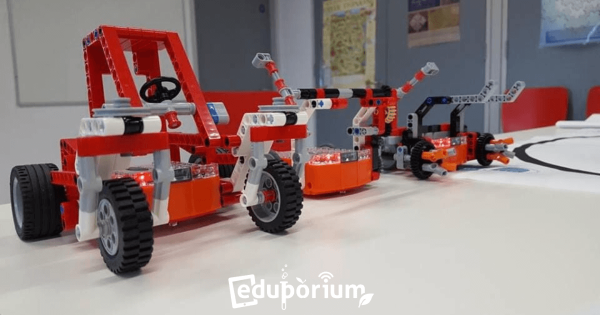The EdCreate Kit is something all STEM teachers should be looking to add to their classrooms. It’s pretty much guaranteed to inflate students’ skills as they expand on Edison’s build with 115 interlocking parts they can use to create five exciting, new robots. The EdTank, EdDigger, EdRoboClaw, EdCrane, and EdPrinter.
Edison Robot
The Edison Robot is one of the most versatile and reliable classroom robotics tools in the education world. Starting with its accessibility, students across the K-12 spectrum could use the Edison in various coding activities and experiments. This helps make your Edison a true K-12 robotics solution. Starting in the early grades, including kindergarten and early elementary school, kids can use their Edison without a screen. This unique robot is pre-programmed to read and react to barcodes that program it in certain modes. Students can line their Edison Robot up next to a barcode, press its record button three times, and then it will drive over the barcode. Once on the other side, the robot is programmed in that specific mode. For this robot, the Edison barcodes include clap-controlled driving (responding to sound), following lines, staying within borders, and more.
In addition to the screen-free barcode programming, older students can also progress to digital coding. There are three main coding environments, which include EdBlocks, EdScratch (based on Scratch), and EdPy (based on Python). Of course, EdBlocks and EdScratch are the more simplistic environments and ideal for elementary students. Then, once they're up in middle school or even high school, students can start using EdPy to program their Edison in Python. Best of all, each one of these Edison coding environments is accessible online. Students don't need any additional downloads to code and learn with this educational robot. Plus, there are various accessories available as well, including the EdSketch Kit. And, for any bigger school STEM programs or afterschool clubs, Edison Class Packs are a great option.
-
Some Halloween STEM—Plus The Edison And Cue Robots
Since it is Halloween and all, we got to thinking about how teachers could celebrate with technology. Sure, they could build something to scare their students, but that could take time and we’re all about helping teachers save time. We thought the next best thing would be adding some appropriately colored robots to the fold. -
Eduporium Experiment | Edison Robot Pt. 2
Edison is the perfect teaching tool for STEM activities since it’s so incredibly versatile. A while ago—about a year now at this point—we were introduced to the Edison Robot and did a nice little write-up on it in what you now know as the Eduporium Experiment. Now, it’s revamped, however, and we’ve got some new stuff to cover, so here -
The Edison Robot: Get Kids Programming in 6 Unique Ways
In the past, the Edison worked with Web-based software called EdWare and was designed for use on Chromebooks. Now, Microbric, its manufacturers, have released new programming software called EdBlocks, which allows kids to program Edison more enjoyably and effectively, including with LEGO compatibility. -
Teaching STEM with Robotics Tools that Grow with Kids
Robotics kits are incredibly valuable for teaching students the skills they really need to know. They’re useful for shaping real problem solving skills, creativity, and, most importantly, coding. The best part? Students can use robotics tools in any grade—starting in Pre-K with super simple models and continuing through high school with the more complex tools. -
Eduporium Weekly | 5 Low-cost Tech Tools for this School Year
It can be overwhelming when trying to find a technologies that are affordable, have longevity, and an easy learning curve. It’s not even that there are not enough like this out there. It’s that there are now too many. We’ve got you covered with five affordable EdTech tools to take into your classroom to start the new school year.
Page
- Page Previous
- Page 1
- You're currently reading page 2









